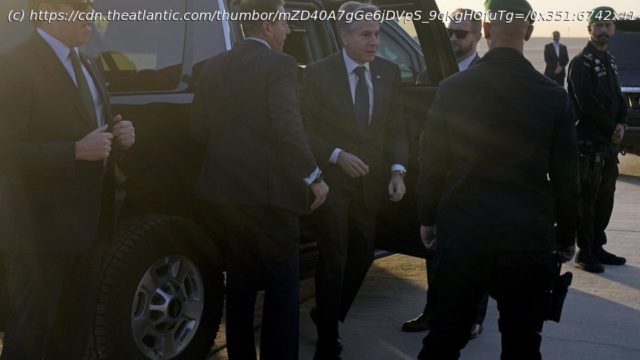Whether Washington can de-escalate tensions will determine the future of its regional authority.
The United States has probably never been under so much pressure to solve the problems of the Middle East. The war in Gaza threatens to spill across the region, and whether Washington can resolve, or even simply contain and de-escalate, the tensions surrounding it may well determine the future of American authority in the Middle East. Whatever the outcome, the current imbroglio is almost certain to mark a turning point for Washington’s role in the region.
That’s why Secretary of State Antony Blinken has set out on a grand tour of American allies in the Middle East with a portfolio of interlocking diplomatic proposals. Blinken’s first objective, and that of U.S. policy more broadly, is to keep the current conflict essentially contained to Gaza, wind it down there, and use the opportunity to construct a more stable Middle East in the aftermath, on the bedrock of Israeli-Saudi relations and Palestinian statehood. But Washington will have a hard time selling this agenda to its adversaries—and an even harder time selling it to its Israeli friends.
The most urgent of the proposals Blinken is pressing relates to the hostages and a pause in the fighting. The United States crafted the plan with significant Israeli, Egyptian, and Qatari input, and finalized it in Paris on January 28.
The Paris proposal reportedly requires Hamas to relinquish all of its remaining hostages, thought to number at least 100, in exchange for a pause of at least 40 days in the fighting. The militants would first release the remaining civilians; then, if the truce holds, soldiers and corpses. But whether Israel will also agree to release any Palestinian prisoners in return remains unclear; certainly no one on Hamas’s wish list of prisoners, which includes senior fighters, is likely to be freed, and Israel will not let go of the popular jailed Fatah leader Marwan Barghouti unless it is ready to finalize a long-term peace agreement with him, much the way South Africa did with Nelson Mandela.
During his visit to Qatar, Blinken revealed that Hamas has responded to this proposal. And it appears to have done so with a substantial counteroffer that almost surely will be a nonstarter for Israel: It calls for a 135-day cease-fire and negotiations to end the conflict in exchange for a three-phase release of all remaining hostages. An addendum demands the release of 1,500 Palestinian prisoners, including many whom Israel considers among the worst terrorists it has ever faced.
Of course Hamas wants a full cease-fire and the withdrawal of Israeli troops. But the 40-day pause in the Paris proposal, if Hamas accepts it, could allow enough humanitarian aid to enter Gaza to save countless civilians from starvation and disease. Refusing that opportunity could be politically costly for Hamas, and in any case, the militants could use the pause to quietly regroup and brace for a resumption of hostilities. In fact, if Hamas played its cards wisely (which is admittedly a long shot) by respecting the pause and focusing on delivering humanitarian aid, planning for reconstruction, and releasing all of the prisoners, it could deprive Israeli Prime Minister Benjamin Netanyahu of a plausible rationalization for resuming his all-out war when the 40 days elapse.
But at this point the hard-liners in Gaza seem tempted to carry on fighting, which will be great news for Netanyahu.






